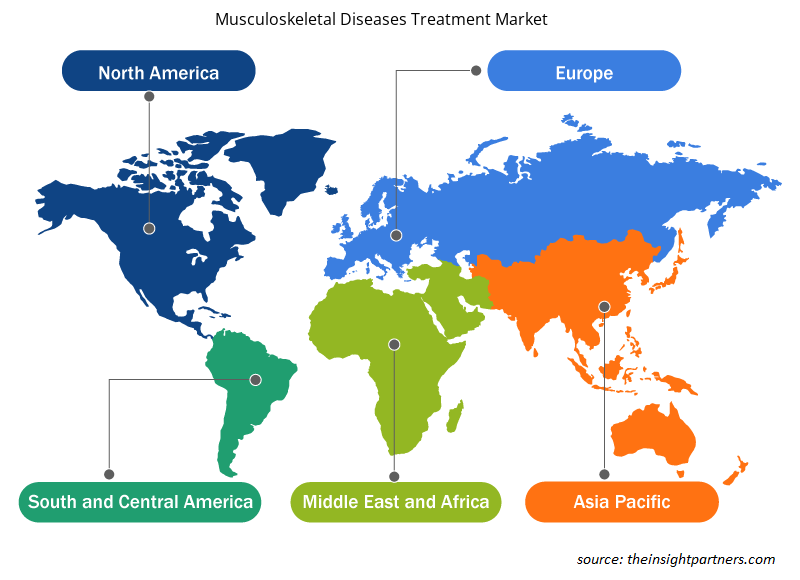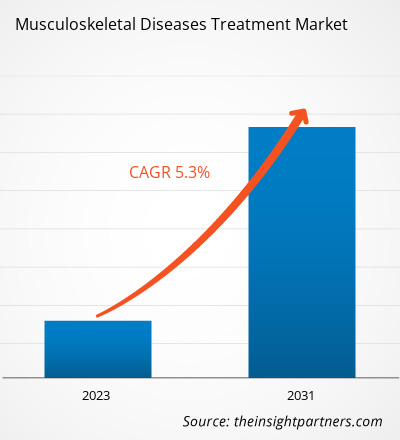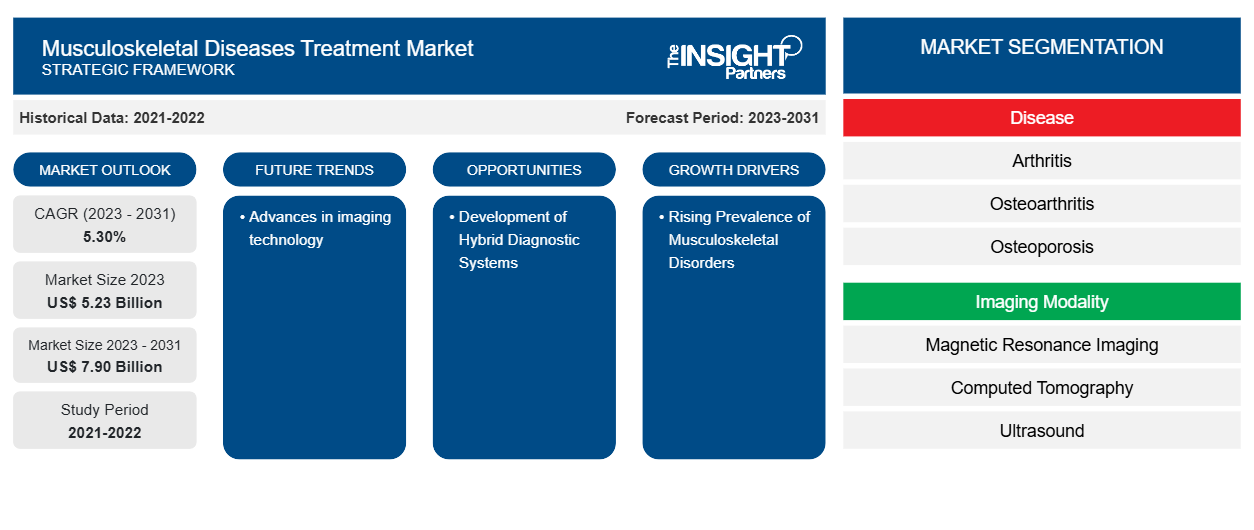Si prevede che la dimensione del mercato del trattamento delle malattie muscoloscheletriche raggiungerà i 7,90 miliardi di dollari entro il 2031, rispetto ai 5,23 miliardi di dollari del 2023. Si prevede che il mercato registrerà un CAGR del 5,30% nel periodo 2023-2031. I progressi nella tecnologia di imaging e le crescenti procedure interventistiche rimarranno probabilmente tendenze chiave nel mercato del trattamento delle malattie muscoloscheletriche.
Analisi di mercato del trattamento delle malattie muscoloscheletriche
Le malattie muscoloscheletriche si riferiscono al gruppo di disturbi che influenzano negativamente muscoli, articolazioni, ossa e altre parti del corpo umano. Tendinite, osteoartrite, spondilite e osteoporosi sono tra le malattie muscoloscheletriche più comuni. I medici spesso diagnosticano le malattie muscoloscheletriche principalmente in base alla storia clinica di un paziente o eseguendo diversi esami fisici. I fattori chiave che guidano il mercato del trattamento delle malattie muscoloscheletriche sono la crescente prevalenza di disturbi muscoloscheletrici, l'aumento della popolazione anziana e i progressi tecnologici nella diagnosi delle malattie muscoloscheletriche. Tuttavia, l'elevato costo dei sistemi diagnostici e la mancanza di professionisti qualificati ostacolano la crescita del mercato.
Panoramica del mercato del trattamento delle malattie muscoloscheletriche
Il Nord America è il mercato più grande per i trattamenti delle malattie muscoloscheletriche, con gli Stati Uniti che detengono la quota di mercato regionale più grande, seguiti dal Canada. La crescita del mercato in Nord America è guidata dalla crescente domanda di prodotti innovativi da parte di aziende di ultrasuoni, PET, SPECT e risonanza magnetica; dalla presenza di attori chiave del mercato; e da un'ampia R&S condotta da vari istituti accademici e di ricerca. Inoltre, la crescente attenzione all'incorporazione di metodi avanzati nell'assistenza sanitaria, iniziative governative e private per la promozione della diagnosi precoce e ingenti fondi da parte di enti governativi e privati per la ricerca muscoloscheletrica contribuiscono alla generazione di entrate per il mercato del trattamento delle malattie muscoloscheletriche in Nord America. La generazione di entrate e la posizione economica globale del Nord America nel mercato globale del trattamento delle malattie muscoloscheletriche.
Personalizza questo report in base alle tue esigenze
Riceverai la personalizzazione gratuita di qualsiasi report, comprese parti di questo report, o analisi a livello nazionale, pacchetto dati Excel, oltre a usufruire di grandi offerte e sconti per start-up e università
-
Scopri le principali tendenze di mercato in questo rapporto.Questo campione GRATUITO includerà analisi di dati che spaziano dalle tendenze di mercato alle stime e alle previsioni.
Driver e opportunità del mercato del trattamento delle malattie muscoloscheletriche
La crescente prevalenza di disturbi muscoloscheletrici favorisce il mercato
Lesioni sportive, infortuni sul lavoro e disfunzioni legate all'età possono causare disturbi muscoloscheletrici. Mal di schiena, artrite reumatoide, osteoartrite, osteoporosi, artrite settica, gotta, miastenia grave e lupus eritematoso sistemico (LES) sono tra le malattie muscoloscheletriche più comuni. Il sistema muscoloscheletrico è la diagnosi e la gestione di tutte le condizioni acute e croniche che influenzano negativamente il sistema muscoloscheletrico, tra cui ossa, muscoli, tendini, articolazioni e legamenti, e il trattamento delle lesioni non chirurgiche del sistema muscoloscheletrico. Quasi 300.000 neonati e bambini sono affetti da artrite o da una condizione reumatica. Il tipo comune di artrite è l'osteoartrite, che colpisce circa 31 milioni di americani. Entro la fine del 2040, il numero di persone che si prevede avranno un'artrite diagnosticata dal medico sarà superiore a 78 milioni. Pertanto, la crescente prevalenza di malattie muscoloscheletriche guida la crescita del mercato dei trattamenti per le malattie muscoloscheletriche.myasthenia gravis, and systemic lupus erythematous (SLE) are among the most common musculoskeletal diseases. The musculoskeletal system is the diagnosis and management of all acute and chronic conditions adversely affecting the musculoskeletal system, including bones, muscles, tendons, joints, and ligaments, and the treatment of non-surgical lesions of the musculoskeletal system. Almost 300,000 babies and children are affected by arthritis or a rheumatic condition. The common type of arthritis is osteoarthritis, which affects ∼31 million Americans. By the end of 2040, number of people expected to have doctor-diagnosed arthritis will be above 78 million. Thus, the rising prevalence of musculoskeletal diseases drives the the musculoskeletal diseases treatment market growth.
Sviluppo di sistemi diagnostici ibridi
I sistemi MRI ibridi si riferiscono al processo di tecniche di imaging mini-invasive complesse che combinano due modalità per fornire informazioni sull'anatomia e la fisiologia del corpo umano. La MRI può essere combinata con varie altre tecniche di imaging, tra cui la tomografia computerizzata (TC) e la tomografia a emissione di positroni (PET), o semplici strumenti disponibili per l'imaging, come la fluoroscopia a raggi X. L'imaging multimodale è diventato specificamente essenziale poiché le moderne tecniche diagnostiche si concentrano verso livelli molecolari e genetici. La combinazione di PET e MRI ha dimostrato di avere un grande successo negli ultimi dieci anni nella ricerca clinica e preclinica di base. Questi ibridi stanno progredendo in applicazioni cliniche per fornire approfondimenti su varie condizioni mediche, malattie, percorsi biologici e valutazione terapeutica.
Analisi della segmentazione del rapporto di mercato sul trattamento delle malattie muscoloscheletriche
I segmenti chiave che hanno contribuito alla derivazione dell'analisi di mercato del trattamento delle malattie muscoloscheletriche sono la malattia e la modalità di imaging.
- In base alla patologia, il mercato del trattamento delle malattie muscoloscheletriche è segmentato in artrite, osteoartrite, osteoporosi, spondilite e altre. Il segmento dell'artrite ha detenuto la quota di mercato maggiore nel 2023.
- In base alla modalità di imaging, il mercato è segmentato in risonanza magnetica per immagini (MRI), tomografia computerizzata (TC), ultrasuoni e altri. Il segmento della tomografia computerizzata (TC) ha detenuto la quota maggiore del mercato nel 2023.
Analisi della quota di mercato del trattamento delle malattie muscoloscheletriche per area geografica
L'ambito geografico del rapporto di mercato sul trattamento delle malattie muscoloscheletriche è suddiviso principalmente in cinque regioni: Nord America, Asia Pacifico, Europa, Medio Oriente e Africa, e Sud e Centro America.
Il Nord America ha dominato il mercato del trattamento delle malattie muscoloscheletriche. Per diversi milioni di americani, la qualità dell'assistenza sanitaria è simboleggiata dalla qualità delle cure radiologiche disponibili nella loro regione. Secondo l'American Society of Radiologic Technologists 2023, negli Stati Uniti vengono eseguite annualmente circa 275 milioni di procedure di radiologia convenzionale. Sono state emanate normative governative per testare ed etichettare gli impianti passivi per la sicurezza e la compatibilità nell'ambiente di risonanza magnetica (RM). Negli Stati Uniti, la Divisione di salute radiologica all'interno del Center for Devices and Radiological Health (CDRH) della Food and Drug Administration (FDA) degli Stati Uniti fornisce la sicurezza e l'efficacia dei dispositivi medici e la sicurezza dei prodotti elettronici che emettono radiazioni. Inoltre, il governo degli Stati Uniti ha deciso di stringere le redini delle macchine a ultrasuoni e di apparecchiature di imaging simili per prevenire l'abuso di queste macchine per la selezione del sesso e altri problemi.
Approfondimenti regionali sul mercato del trattamento delle malattie muscoloscheletriche
Le tendenze regionali e i fattori che influenzano il mercato del trattamento delle malattie muscoloscheletriche durante il periodo di previsione sono stati ampiamente spiegati dagli analisti di Insight Partners. Questa sezione discute anche i segmenti del mercato del trattamento delle malattie muscoloscheletriche e la geografia in Nord America, Europa, Asia Pacifico, Medio Oriente e Africa e Sud e Centro America.

- Ottieni i dati specifici regionali per il mercato del trattamento delle malattie muscoloscheletriche
Ambito del rapporto di mercato sul trattamento delle malattie muscoloscheletriche
| Attributo del report | Dettagli |
|---|---|
| Dimensioni del mercato nel 2023 | 5,23 miliardi di dollari USA |
| Dimensioni del mercato entro il 2031 | 7,90 miliardi di dollari USA |
| CAGR globale (2023-2031) | 5,30% |
| Dati storici | 2021-2022 |
| Periodo di previsione | 2023-2031 |
| Segmenti coperti |
Per malattia
|
| Regioni e Paesi coperti |
America del Nord
|
| Leader di mercato e profili aziendali chiave |
|
Densità degli operatori del mercato del trattamento delle malattie muscoloscheletriche: comprendere il suo impatto sulle dinamiche aziendali
Il mercato del trattamento delle malattie muscoloscheletriche sta crescendo rapidamente, spinto dalla crescente domanda degli utenti finali dovuta a fattori quali l'evoluzione delle preferenze dei consumatori, i progressi tecnologici e una maggiore consapevolezza dei benefici del prodotto. Con l'aumento della domanda, le aziende stanno ampliando le loro offerte, innovando per soddisfare le esigenze dei consumatori e capitalizzando sulle tendenze emergenti, il che alimenta ulteriormente la crescita del mercato.
La densità degli operatori di mercato si riferisce alla distribuzione di aziende o società che operano in un particolare mercato o settore. Indica quanti concorrenti (operatori di mercato) sono presenti in un dato spazio di mercato in relazione alle sue dimensioni o al valore di mercato totale.
Le principali aziende che operano nel mercato del trattamento delle malattie muscoloscheletriche sono:
- ELETTRICA GENERALE
- CONIUGE PHILIPS NV
- SIEMENS AG
- AZIENDA DI SISTEMI MEDICI CANON
- Hitachi, Ltd
- Accuray Incorporated
Disclaimer : le aziende elencate sopra non sono classificate secondo un ordine particolare.

- Ottieni la panoramica dei principali attori del mercato del trattamento delle malattie muscoloscheletriche
Notizie e sviluppi recenti sul mercato del trattamento delle malattie muscoloscheletriche
Il mercato del trattamento delle malattie muscoloscheletriche viene valutato raccogliendo dati qualitativi e quantitativi post-ricerca primaria e secondaria, che includono importanti pubblicazioni aziendali, dati di associazioni e database. Di seguito sono elencati alcuni degli sviluppi nel mercato del trattamento delle malattie muscoloscheletriche:
- Solera Health ha lanciato la sua nuova offerta Musculoskeletal (MSK) attraverso le migliori soluzioni di terapia digitale MSK: SWORD Health, Kaia Health e Sworkit. L'azienda afferma che la sua nuova offerta MSK affronterà un continuum di condizioni muscoloscheletriche attraverso servizi subclinici che spaziano dal benessere preventivo, alla gestione di infortuni e condizioni croniche, nonché alla riabilitazione preoperatoria e postoperatoria attraverso la sua rete in espansione di interventi digitali di alto livello basati su prove. (Fonte: Solera Health, comunicato stampa, 2021)
Copertura e risultati del rapporto di mercato sul trattamento delle malattie muscoloscheletriche
Il rapporto "Dimensioni e previsioni del mercato del trattamento delle malattie muscoloscheletriche (2021-2031)" fornisce un'analisi dettagliata del mercato che copre le seguenti aree:
- Dimensioni e previsioni del mercato del trattamento delle malattie muscoloscheletriche a livello globale, regionale e nazionale per tutti i segmenti di mercato chiave coperti dall'ambito
- Tendenze del mercato del trattamento delle malattie muscoloscheletriche e dinamiche di mercato come fattori trainanti, restrizioni e opportunità chiave
- Analisi dettagliata delle cinque forze PEST/Porter e SWOT
- Analisi di mercato del trattamento delle malattie muscoloscheletriche che copre le principali tendenze del mercato, il quadro globale e regionale, i principali attori, le normative e i recenti sviluppi del mercato
- Analisi del panorama industriale e della concorrenza che copre la concentrazione del mercato, l'analisi della mappa di calore, i principali attori e gli sviluppi recenti per il mercato del trattamento delle malattie muscoloscheletriche
- Profili aziendali dettagliati
- Analisi storica (2 anni), anno base, previsione (7 anni) con CAGR
- Analisi PEST e SWOT
- Valore/volume delle dimensioni del mercato - Globale, Regionale, Nazionale
- Industria e panorama competitivo
- Set di dati Excel
Report recenti
Testimonianze
Motivo dell'acquisto
- Processo decisionale informato
- Comprensione delle dinamiche di mercato
- Analisi competitiva
- Analisi dei clienti
- Previsioni di mercato
- Mitigazione del rischio
- Pianificazione strategica
- Giustificazione degli investimenti
- Identificazione dei mercati emergenti
- Miglioramento delle strategie di marketing
- Aumento dell'efficienza operativa
- Allineamento alle tendenze normative























 Ottieni un campione gratuito per - Mercato del trattamento delle malattie muscoloscheletriche
Ottieni un campione gratuito per - Mercato del trattamento delle malattie muscoloscheletriche